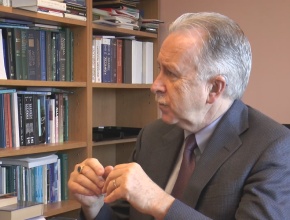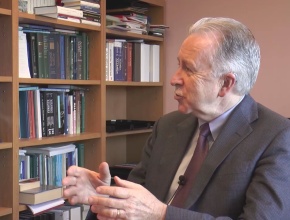References
Du Toit G, Roberts G, Sayre PH, et al; LEAP Study Team. Randomized trial of peanut consumption in infants at risk for peanut allergy. N Engl J Med. 2015 Feb 26;372(9):803-13. doi: 10.1056/NEJMoa1414850. Epub 2015 Feb 23. Erratum in: N Engl J Med. 2016 Jul 28;375(4):398. PubMed PMID: 25705822; PubMed Central PMCID: PMC4416404.Du Toit G, Sayre PH, Roberts G, et al; Immune Tolerance Network LEAP-On Study Team. Effect of Avoidance on Peanut Allergy after Early Peanut Consumption. N Engl J Med. 2016 Apr 14;374(15):1435-43. doi: 10.1056/NEJMoa1514209. Epub 2016 Mar 4. PubMed PMID: 26942922.
Roman Jaeschke: We reviewed, or you reviewed, the history of inhaled corticosteroids, the history of use of short- and long-acting ß2-agonists, safety concerns of those, use of muscarinic antagonists (short- and long-acting), use of aminophylline, use of magnesium; so, that is all history and present. You have already mentioned some very new types of therapies, including biologics. Where is the future going, if you could predict? I know that it is difficult to predict but…
Paul O’Byrne: I think the future – if I were really optimistic, which I like to be, mostly – will be in primary prevention of asthma. And I think that there are some very, very interesting and tremendously exciting insights into the reasons why some children develop atopic allergic diseases, of which asthma is a component in some of these children, and most children do not. It appears to be, almost certainly, events occurring at a very critical time, shortly after birth, that drive the child’s immune system in one way or another, which can leave this child with the propensity to having allergic diseases or not. Certainly part of it is genetic – there is no doubt about that – but there are really important environmental drivers for this differentiation, and we are getting to understand what they are. If we understand what they are, then intervening at a child at risk in a family with a history of atopy I think is a tremendously exciting opportunity to change the path this child’s immune system will have for the rest of that individual’s life. For example, we are discovering that a child born to a household that has pets, particularly dogs, has a 50% reduction in having atopic disease.
RJ: I am happy to hear it is reduction.
PO: It is reduction. Mind you, if the child develops atopic disease and has an animal in the home, particularly cats, the likelihood of having bad diseases is increased, so it is a yin and yang situation.
What it is about pet ownership that may be critical? There is also really good evidence that infants born in a rural versus an urban setting, particularly a rural setting where they are exposed to lots of animals and barns and farms, the risk of atopic diseases and asthma is markedly reduced. So there is something in that environment that is driving the immune system; it is flicking a switch that allows it to go one way rather than another way. And there are some very exciting studies starting, which will help us understand whether we can modulate that immune system switch early on. If we can, of course, then the need for all these drugs for asthma will disappear, which would be the perfect solution.
If I can just say one other thing, because there is a proof of principle in this regard: a series of studies, led by Professor Gideon Lack at Imperial College in London, that looked at the question of why in many developed countries the prevalence of peanut allergy is increasing dramatically. Here in Canada, somewhere between 5% and 7% of children are thought to be peanut allergic, and it is in fact resulting in many schools not allowing peanut butter sandwiches, not having peanuts on airplanes, and all this sort of consequences of putting people at risk of having a bad reaction, because severe anaphylaxis from peanuts is well identified and there have been, as you know, deaths from inadvertent ingestion of peanuts. What Dr. Lack noticed was that in Israel, where he had worked, peanut allergy is almost unknown, while in the United Kingdom, where he worked, it was 5% to 7% of children. Why was that? Well, it could have been genetics. But when he looked into that, in fact children of Israeli origin who had moved to other countries had this increased risk while they did not have it in Israel. So something environmental. And something he identified was that in Israel one of the first foods that children get after weaning was a food that contained peanuts. So he developed a hypothesis that feeding children this peanut-based food early on again was something that drove the immune system one way to develop protective mechanisms against developing an allergy to peanuts. He did a large clinical trial, again published in the New England Journal of Medicine about 2 years ago, and he was absolutely right. The children in both Israel and England who got this food early on had essentially no peanut allergy, and those that did not [receive peanuts early] had the prevalence rates that were consistent with the community. There has been a publication just this week, again the New England Journal of Medicine, a follow-up of some of these cohorts, and even I think at age 10 years when they stopped eating peanuts for a year the allergy did not recur. It seemed to provide long-term immune protection against this event. So we do have a proof of principle with at least one form of allergy that this can work.
RJ: Well, it is very interesting. I would like to thank you for going through the history of asthma, through the present, and through the future, and I hope this is of use to our users. Thank you very much.
PO: Great pleasure. Thank you.
 English
English
 Español
Español
 українська
українська






